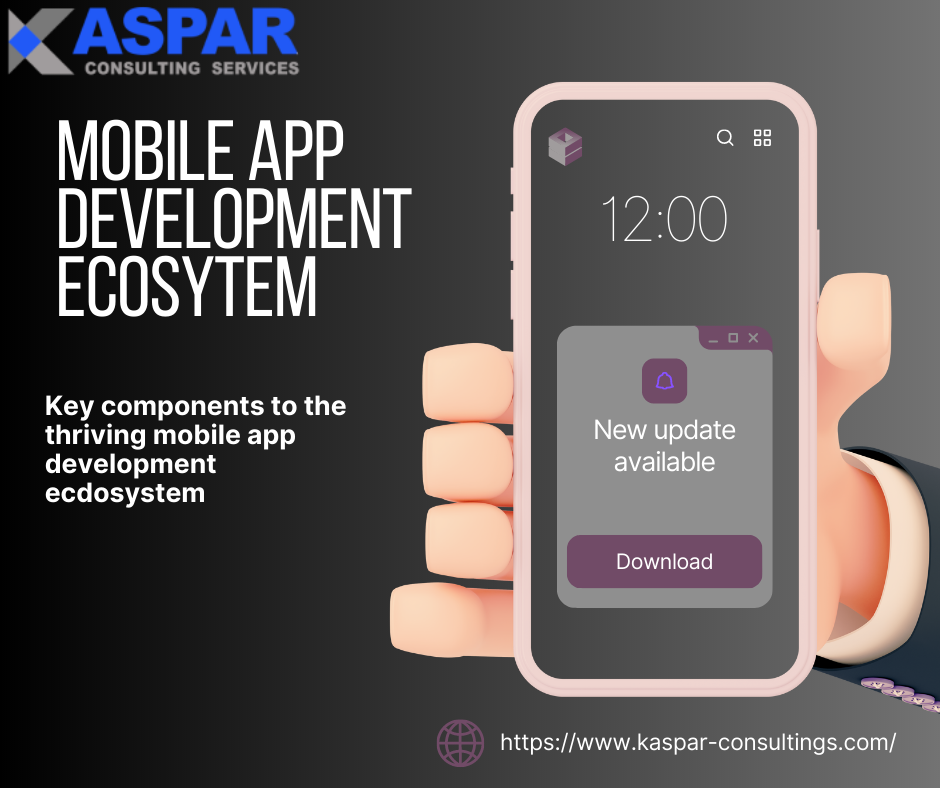- Odoo
- April 22, 2024
- 10 Minutes
Top 5 key components of thriving mobile app development ecosystem


Author
Asim Jibran
A thriving mobile app development ecosystem comprises several key components that work harmoniously to facilitate the creation, launch, and success of mobile applications. Here are some of the key components:
Development Tools and Platforms of Mobile app development ecosystem:
A robust ecosystem provides developers with a variety of development tools and platforms. This includes integrated development environments (IDEs), software development kits (SDKs), and frameworks that simplify the coding process and enable cross-platform development. Popular examples include Android Studio, X code for iOS, Flutter, and React Native.
App Stores and Distribution Platforms in Mobile app development ecosystem:
App stores, such as the Apple App Store and Google Play Store, serve as the primary distribution channels for mobile apps. They offer a massive user base and built-in mechanisms for app discovery, installation, and updates. A thriving ecosystem ensures that these platforms provide a streamlined submission process, effective app review, and visibility for both new and established developers.
Developer Communities and Support:
A strong developer community fosters knowledge sharing, collaboration, and support. Online forums, communities, and resources enable developers to seek help, share best practices, and collaborate on solving challenges. A thriving ecosystem also includes official documentation, tutorials, and sample code to assist developers at all skill levels.
App Monetization Strategies:
For sustainable growth, app developers need effective monetization strategies. A thriving ecosystem offers various options such as in-app purchases, subscription models, freemium, ads, and more. Monetization tools and analytics enable developers to track user engagement, analyze revenue streams, and optimize their apps for better financial outcomes.
User Experience and Design Guidelines:
User experience (UX) and design play a pivotal role in app success. Thriving ecosystems provide guidelines, best practices, and design frameworks to ensure that apps are intuitive, visually appealing, and user-friendly across different devices and platforms. Following platform-specific design guidelines (such as Material Design for Android and Human Interface Guidelines for iOS) helps maintain consistency and familiarity for users
Quality Assurance and Testing Tools:
Robust testing tools and quality assurance practices are essential for delivering bug-free and reliable apps. An ecosystem that supports testing automation, debugging, performance testing, and user acceptance testing helps developers identify and resolve issues before launching their apps.
Security Measures:
Security is paramount in mobile app development. A thriving ecosystem provides resources, guidelines, and tools to ensure that apps are developed with strong security measures in place. This includes secure coding practices, data encryption, authentication mechanisms, and protection against common vulnerabilities.
Emerging Technologies Integration:
The ecosystem’s adaptability to emerging technologies like augmented reality (AR), virtual reality (VR), machine learning (ML), and Internet of Things (IoT) can greatly enhance app capabilities. Support for these technologies through SDKs, APIs, and development frameworks encourages innovation and differentiation.
User Feedback and Iteration:
A thriving ecosystem values user feedback and encourages iterative development. It provides channels for users to provide feedback, report issues, and suggest improvements. Developers can then incorporate this feedback into future updates, enhancing user satisfaction and retention.
Legal and Compliance Guidance:
Mobile apps must adhere to legal requirements and industry standards. An ecosystem that offers guidance on privacy regulations, terms of use, and accessibility standards ensures that developers create apps that are compliant and respectful of users’ rights.
Support for Diversity and Inclusion:
A successful ecosystem promotes diversity and inclusion by offering tools and resources to create apps that are accessible to users with disabilities, available in multiple languages, and cater to diverse user needs and preferences.
Continuous Learning and Skill Development:
The mobile app development landscape evolves rapidly. A thriving ecosystem encourages continuous learning through online courses, workshops, conferences, and webinars. It supports skill development to keep developers up to date with the latest technologies and trends.
Cloud Services Integration:
Cloud services facilitate data storage, synchronization, and scalability for mobile apps. A thriving ecosystem provides seamless integration with cloud platforms like Amazon Web Services (AWS),Google Cloud, and Microsoft Azure to ensure reliable app performance and data management.
Feedback and Bug Reporting Channels:
Ecosystems that offer easy ways for users to report bugs and provide feedback contribute to ongoing app improvement. Thisdirect communication with users helps developers identify issues and make necessary fixes promptly.
Analytics and Insights:
Providing tools for tracking app usage, user engagement, and performance metrics is crucial. Access to analytics helps developers make informed decisions about app enhancements, content updates, and marketing strategies.
While these are the core components, it’s important to note that a thriving mobile app development ecosystem is also influenced by factors like security measures, continuous integration and deployment practices, access to APIs and third-party integrations, marketing and app promotion strategies, and the evolving landscape of emerging technologies (such as augmented reality, Internet of Things, and machine learning) that can enhance app capabilities.
Successful mobile app development depends on a holistic approach that embraces these components and allows developers to create innovative, high-quality, and user-centric applications.
Here are the top 5 key components of a thriving mobile app development ecosystem:
Abundant talent pool:
A thriving mobile app development ecosystem needs a large and skilled pool of mobile app developers. This can be achieved through a combination of factors, such as a strong educational system that produces mobile app developers, a vibrant startup culture that attracts and retains mobile app developers, and a supportive government that provides incentives for mobile app development.
Strong infrastructure:
A thriving mobile app development ecosystem also needs a strong infrastructure in place to support the development and deployment of mobile apps. This includes things like high-speed internet, are liable power grid, and a robust cloud computing platform.
A vibrant app market:
A thriving mobile app development ecosystemneeds a vibrant app market where users can easily find and download mobileapps. This can be achieved through things like a well-established app store, astrong marketing campaign, and a positive user experience.
A supportive regulatory environment:
A thriving mobile app development ecosystem also needs a supportive regulatory environment that does not stifle innovation. This can be achieved through things like clear and concise regulations, a fair and transparent licensing process, and a government that is open to new ideas.
A strong community:
A thriving mobile app development ecosystem also needs a strong community of mobile app developers, users, and businesses. This community can help to share knowledge, provide support, and foster innovation.
These are just some of the key components of a thriving mobile app development ecosystem. By ensuring that these components are in place, governments, businesses, and organizations can help to create a vibrant and supportive environment for mobile app development.
Book Free Demo
In addition to the above, here are some other factors that can contribute to a thriving mobile app development ecosystem:
● A strong focus on user experience: Mobile apps are all about providing a great user experience. If your apps are not user-friendly and engaging, users will quickly uninstall them.
● Regular updates and bug fixes: Mobile apps are constantly evolving, and it is important to keep your apps up-to-date with the latest features and bug fixes.
● A strong marketing campaign: In order to be successful, your mobile apps need to be seen by potential users. A strong marketing campaign can help to get the word out about your apps and drive downloads.
● A commitment to customer support: If users have problems with your apps, they need to be able to get help quickly and easily. A good customer support system can help to improve user satisfaction and loyalty.
By focusing on these factors, you can help to create a thriving mobile app development ecosystem that benefits businesses, users, and society as a whole.
Here are some specific examples of how the key components of a thriving mobile app development ecosystem can benefit businesses, users, and society as a whole:
● Abundant talent pool: A large and skilled pool of mobile app developers can help businesses to develop and launch new mobile apps more quickly and easily. This can give businesses a competitive advantage in the marketplace.
● Strong infrastructure: A strong infrastructure in place to support the development and deployment of mobile apps can help businesses to save time and money. This can free up businesses to focus on their core competencies and grow their business.
● Vibrant app market: A vibrant app market where users can easily find and download mobile apps can help businesses to reach a wider audience and increase sales.
● Supportive regulatory environment: A supportive regulatory environment that does not stifle innovation can help businesses to develop new and innovative mobile apps. This can help businesses to stay ahead of the competition and grow their business.
● Strong community: A strong community of mobile app developers, users, and businesses can help businesses to share knowledge, get feedback, and find partners. This can help businesses to develop better mobile apps and grow their business.
In addition to the benefits for businesses, a thriving mobile app development ecosystem can also benefit users and society asa whole.
Forexample, a thriving mobile app development ecosystem can:
● Provide users with access to awider variety of mobile apps that can improve their lives.
● Create new jobs and opportunities for mobile app developers and other tech workers.
● Drive economic growth and innovation.
● Improve communication and collaboration.
● Promote social and civic engagement.
Overall, a thriving mobile app development ecosystem can have a positive impact on businesses, users, and society as a whole. By ensuring that the key components of a thriving mobile app development ecosystem are in place, governments, businesses, and organizations can help to create a vibrant and supportive environment for mobile app development.
For Latest Trends
FAQ about the top 5 key components of a thriving mobile app development ecosystem:
1. What are the key components of a thriving mobile app development ecosystem?
A thriving mobile app development ecosystem consists of several crucial components that work together to ensure successful app creation and deployment. These components include ideation, development tools, user experience (UX) design, testing, and app marketing.
2. Why is ideation important in the mobile app development ecosystem?
Ideation is the process of generating and refining app ideas. It’s crucial because a well-defined and innovative app idea forms the foundation for a successful project. By thoroughly exploring and validating ideas, developers can identify market needs, target audiences, and unique selling points.
3. How do development tools contribute to a thriving mobile app development ecosystem?
Development tools, including integrated development environments (IDEs), software frameworks, and libraries, streamline the coding process. They provide pre-built components, debugging features, and coding assistance, which help developers save time, reduce errors, and create efficient and reliable apps.
4. What role does user experience(UX) design play in mobile app development?
User experience (UX) design focuses on creating a seamless, user-friendly interface and interaction flow within the app. A positive UX enhances user satisfaction and encourages engagement, leading to higher app retention rates and better reviews. It involves aspects like intuitive navigation, attractive visuals, and responsive design.
5. Why is testing essential in the mobile app development process?
Testing is a critical component to ensure app functionality, stability, and security. Thorough testing identifies and resolves bugs, compatibility issues, and performance bottlenecks before the app reaches users. Testing includes unit testing, integration testing, usability testing, and security testing.
Conclusion
In conclusion, a thriving mobile app development ecosystem encompasses a wide range of components that collectively empower developers to create successful, user-friendly, and innovative apps. It encourages collaboration, fosters learning, emphasizes security and compliance, and provides the necessary tools and resources to navigate the dynamic landscape of mobile app development. As technology evolves, an ecosystem that supports flexibility and growth will continue to play a crucial role in the success of mobile applications.




